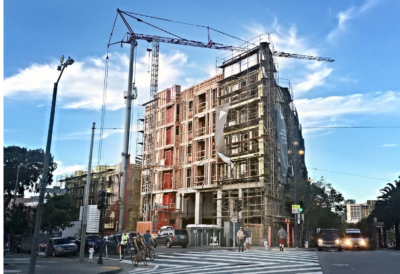California Resilience Challenge Spotlight: Santa Ana Regional Transportation Center
This is one in a series of profiles of the 12 winners of the California Resilience Challenge, a first-of-its-kind statewide initiative of the Bay Area Council and a diverse array of partners. The Challenge recently awarded $2 million in planning grants for a variety of innovative projects in communities across the state to address the growing impacts of climate change, including drought, floods, wildfires and sea-level rise.
The Santa Ana Regional Transportation Center (SARTC) is the focal point of transportation in Orange County – but the facility is at risk of service disruption and damage during severe climate events, including power outages due to flooding and extreme heat events. With support from the California Resilience Challenge, SARTC is conducting a microgrid feasibility study that could enable this critical facility to continue serving the community even during the most extreme climate events.
Microgrids can be valuable resources for community resilience, particularly if they can operate independently, as islands, from the grid during times of grid stress or failure. “A feasibility study focused on a permanently installed, islandable microgrid will help the city achieve critical emergency preparedness goals and maintain important operations and resources in the event of a climate emergency” said John Rossi, Program Manager of Commercial and Institutional Energy at TRC.
In addition to providing train, bus, taxi, and airport transportation services, the SARTC facility also hosts three electric vehicle (EV) chargers for public use. Through this study, the City of Santa Ana and SARTC will assess the feasibility of incorporating additional EV charging infrastructure as well as adding solar photovoltaics on SARTC parking structures and incorporating battery storage. Collectively, these measures could significantly reduce greenhouse gas emissions from the facility and improve overall air quality.
“The SARTC resilient transportation hub microgrid solution will not only enhance energy efficiency and resiliency but will also help the City demonstrate the technical and economic feasibility, and replicability of microgrid projects to other cities across the State of California” explained Rossi. “So far, this integrated approach has not been adequately supported by competitive or regulated markets.” Within the SARTC resilient transportation hub specifically, the microgrid will demonstrate the feasibility of harnessing solar energy through generation and battery energy storage deployment approaches.
As a tool to build cohesiveness and a common sense of purpose, the SARTC microgrid will also promote education and community engagement. The project will include an education component that will equip the community and employees with knowledge about storm preparation, response planning, and readiness exercises. Creating an educational model for resilience-focused private-public collaboration will ensure wide-spread acceptance, as well as the efficacy and sustainability of the adaptation program. To learn more about the California Resilience Challenge, please contact Policy Associate Anna Sciaruto.




